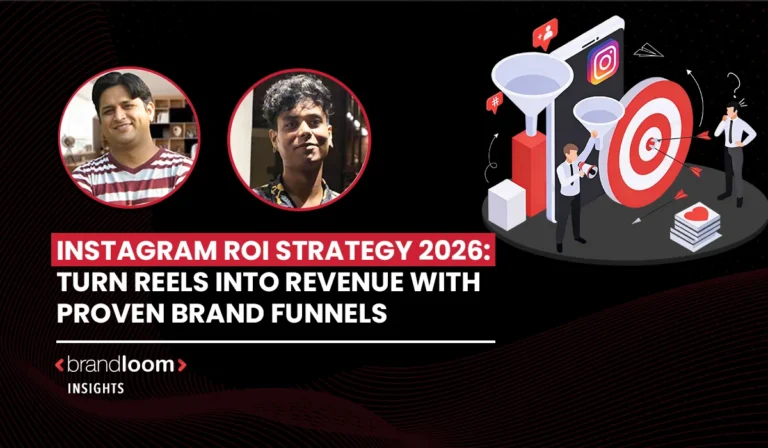According to recent research, 80% of consumers consider price the most essential factor before purchasing any product or service. This emphasizes the significance of what is price in marketing and how companies can take full advantage of it.
A company’s success or failure often depends on its pricing strategy. Whether a customer will buy anything depends largely on their willingness to spend.
However, putting a price on a product or service is not always easy. It necessitates an in-depth awareness of the market, the rivals, and customer preferences.
The failure of a company is directly proportional to its price approach. However, a strategic approach to pricing may help firms generate revenue, retain customers, and maximize earnings.
This article will discuss the role of price in marketing, the many approaches to pricing that organizations may take, and the process of arriving at an appropriate price.
As a leading marketing consultancy firm, we at BrandLoom can tell you all about how price affects customers and help you create a proper pricing strategy.
What Is Price In Marketing?
When it comes to marketing, price is a major factor that may make or break a company. One research found that raising prices by 1% resulted in an 8.7% rise in operational earnings for the typical business.
Cost of production, level of competition, and consumer preferences are just a few of the considerations that go into setting prices. However, firms must take into account the customers’ subjective valuations, pricing sensitivities, and price references while making decisions.
Price and Value: The Difference in Consumer Perceptions
Another popular study found that consumers are willing to pay a higher price for goods they perceive as having higher quality. For instance, people often pay a higher price for organic or environmentally friendly options.
People tend to prefer buying items that are priced oddly, like $4.99 instead of $5.00, because they perceive these prices as more reasonable.
Businesses may respond to fluctuations in supply and demand using a variety of pricing techniques, including cost-plus pricing, value-based pricing, and dynamic pricing.
Companies are increasingly turning to algorithms to dynamically price goods and services in response to changing market demand and cost factors.
However, companies also need to be mindful of the potential dangers and difficulties that might arise from pricing decisions, such as price wars, discrimination, and collusion. So, before settling on a pricing plan, firms need to understand the market and the habits of their target demographic.
To put it simply, the price tag attached to a product or service is a major factor in the marketing mix.
Businesses may boost earnings, market share, and customer loyalty with the help of strategic pricing.
However, companies also need to be alert to the hazards and difficulties price might provide so that they can plan properly.
What Are the Objectives Of Pricing?
Profitability, market share, and client loyalty are all aspects of marketing that price decisions may impact.
Pricing is the most vital element of the marketing mix when it comes to influencing consumer behavior and, ultimately, a company’s success.

These are the major goals of pricing:
1. Profitability:
Setting the proper price for a product or service is essential to achieving this goal of profitability. Businesses should consider manufacturing costs, market rivalry, and consumer preferences when deciding on pricing.
2. Market Share:
Gaining market share via pricing involves establishing a price that is lower than that of rivals. Businesses often use this tactic (known as “penetration pricing”) when first exploring a new market.
3. Customer Loyalty:
Strategic pricing strategies like sales and promotions can earn loyal customers. Businesses often use this tactic in an effort to prolong the worth of their current clientele.
4. Brand Image:
Setting an expensive price for a product or service might help establish a more prestigious reputation for the brand. Luxury companies often use this tactic to demonstrate their superiority and exclusivity.
5. Survival:
Businesses may guarantee their continued existence via pricing by charging enough to cover their production costs and operating expenditures. Companies often use this tactic when confronted with severe competition or economic downturns.
After learning about the importance of pricing in marketing and its many goals, it is appropriate to dig into the world of the marketing mix. This is because the marketing mix greatly influences pricing methods.
What Is A Marketing Mix
A company’s marketing mix consists of the many aspects of promoting a product or service that are within its direct control. Product, pricing, promotion, and location are the “Four Ps” of marketing, another name for the marketing mix. Together, they form a cohesive marketing plan that brings about the desired results for firms.
Recent research found that firms with a defined marketing mix were 2.8% more likely to generate a profit than those without one.
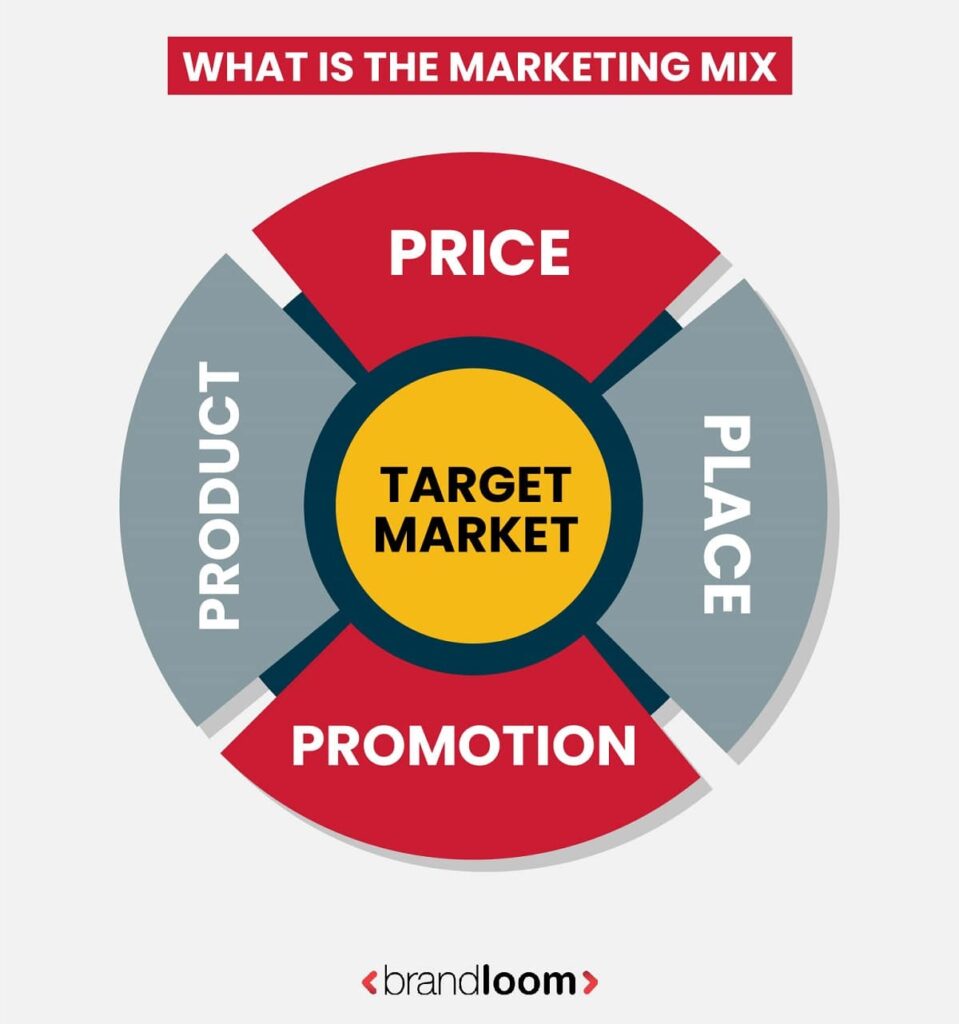
The research also discovered that companies who use a marketing mix had a better chance of accomplishing their marketing objectives, such as growing their customer base, attracting new clients, and retaining current ones.
A company’s product is whatever it is that it sells to consumers.
A product is the items or services that a company provides to its clients. It comprises the product’s design, features, quality, and packaging. The consumer pays the price for a service or product. Pricing strategy, discounts, and payment conditions are all part of it.
Promotion is the process through which a company communicates with its target market and promotes its goods or services. It includes everything from sales promotions to personal selling, public relations, and advertising.
A business’s distribution channels to reach customers are called “place.” It consists of the physical location, distribution networks, and logistics. The marketing mix is a fluid idea that firms may modify to suit the changing demands of their target market and accomplish their marketing objectives.
Businesses may adapt the marketing mix to match the ever-evolving demands of their target audience and advance their marketing objectives. The marketing mix is a framework for developing a holistic strategy for the marketing process that takes into account everything from new product creation to customer retention.
What Is Price In The Marketing Mix?
Price is an important marketing mix component that influences a company’s performance. The major purpose of price in the marketing mix is to maximize revenues by appropriately pricing the product or service.
Pricing choices are influenced by a variety of variables, including manufacturing costs, competition, and consumer behavior. These variables must be carefully considered by businesses in order to determine pricing that is competitive, lucrative, and appealing to consumers.
Setting a cheaper price than rivals may also be utilized to acquire market share. This method is known as penetration pricing and is often utilized by companies entering a new market.
According to one survey, 25% of customers are likely to switch brands at a 20% or greater discount. As a result, firms may utilize price to attract new consumers and increase market share.
By giving discounts, promotions, and loyalty programs, the price may also be utilized to promote client loyalty. According to a different survey, 75% of customers are inclined to make a purchase from a business if it knows about their previous purchases, knows who they are by name, or offers suggestions based on those purchases.
As a result, organizations may utilize price to boost client lifetime value and promote customer loyalty.
Setting premium pricing for a product or service may also be utilized to build a brand image. Luxury businesses often use this tactic to project an impression of exclusivity and high quality. For instance, luxury firms with premium pricing have larger profit margins than those with bargain pricing.
What Is Pricing Strategy In Marketing?
In marketing, pricing strategy refers to how a company determines the price of its goods or services. It is an essential aspect of the marketing mix that might significantly affect how effectively a company succeeds.
When deciding on a pricing plan, businesses must carefully analyze market circumstances as well as client behavior. By implementing the proper pricing strategy, businesses may boost their profitability, market share, and customer loyalty.
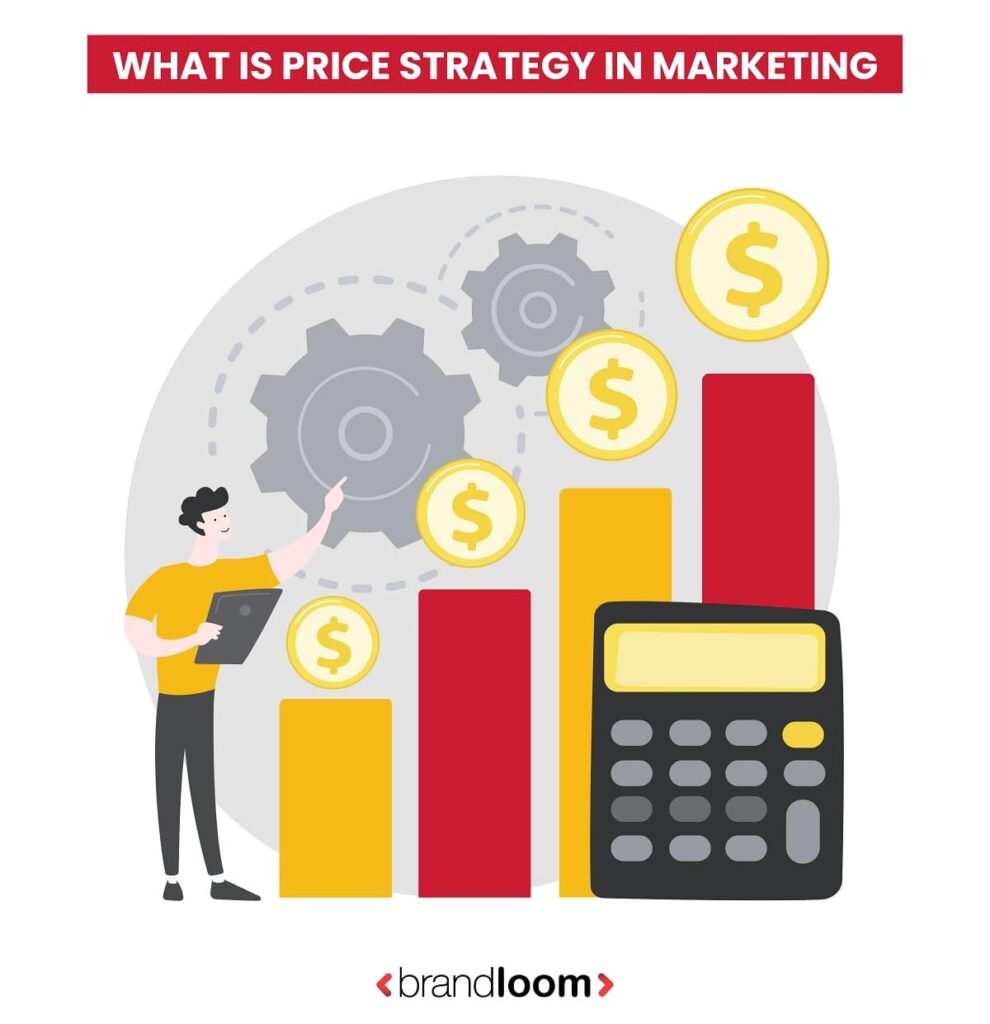
According to research, businesses that adopt a value-based pricing approach are 30% more profitable than those that utilize a cost-plus pricing strategy.
According to the report, companies that utilize a dynamic pricing strategy may improve revenue by up to 10% by modifying prices in real-time, depending on market circumstances and consumer behavior.
Finally, pricing strategy in marketing is a vital component that may greatly influence a company’s performance. Businesses may adopt the correct pricing strategy to maximize profits, gain market share, and establish customer loyalty by carefully evaluating market circumstances and consumer behavior.
Types Of Pricing Strategies In Marketing
Businesses may employ a variety of pricing strategies in their marketing. These tactics are intended to assist companies in determining the appropriate pricing for their goods or services in order to meet their marketing objectives. Here are some examples of standard pricing strategies:
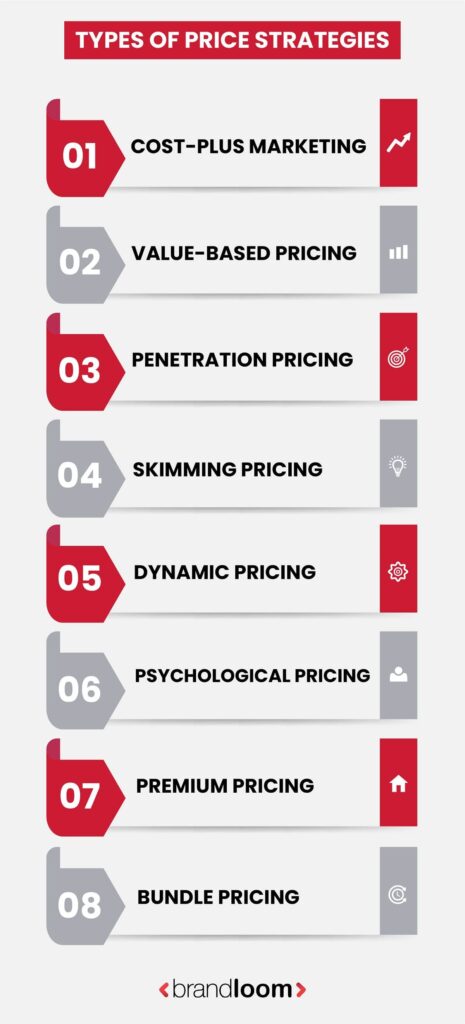
1. Cost-plus pricing:
In this pricing technique, the selling price is determined by adding a markup to the cost of manufacturing. The markup is often a percentage of the cost of manufacturing and is used to pay overhead expenditures while still making a profit.
Businesses that aim to pay their expenses and create a profit often use this method. It may not, however, be the most successful pricing approach for organizations looking to maximize profits or increase market share.
2. Value-based pricing:
This pricing technique includes determining the price based on the customer’s perceived product or service value. The price is determined by the advantages received by the client rather than the cost of manufacturing.
Businesses that wish to separate themselves from the competition and build a premium brand image often use this method. However, it may not be the most successful price approach for companies looking to enter a new market or increase market share.
3. Penetration pricing:
In order to increase market share, this pricing approach entails establishing a low price for a new product or service. The objective is to entice clients away from rivals by providing a cheaper price.
Businesses that are entering a new market or attempting to increase market share often use this method. However, it may not be the best pricing approach for organizations looking to maximize earnings or establish a premium brand image.
4. Skimming pricing:
This pricing strategy is charging a high price for a new product or service in order to recuperate R&D expenditures. The objective is to reach out to early adopters who are prepared to pay a premium for the product or service.
This method is often utilized by organizations that have spent considerably in R&D and want to swiftly return their investment. However, it may not be the most successful pricing approach for companies looking to grow market share or optimize profits over time.
5. Dynamic pricing:
This pricing technique entails real-time price adjustments depending on market circumstances and client behavior. The objective is to maximize income by charging the appropriate price at the appropriate time.
Businesses that compete in industries with significant rivalry and unpredictable demand often use this method. However, it may not be the most successful price approach for organizations looking to generate client loyalty or create a premium brand image.
6. Psychological pricing:
In this pricing method, the price is determined by the customer’s impression of the goods or services. For example, setting a price of $9.99 instead of $10.00 might make the product seem more reasonable to shoppers.
Businesses that aim to influence client behavior and enhance revenue often use this method. It may not, however, be the most successful price approach for firms looking to establish a premium brand image or separate themselves from the competition.
7. Premium pricing:
This pricing approach charges a premium price for a product or service to project an impression of exclusivity and high quality. Luxury businesses often use this tactic to project an impression of exclusivity and high quality. However, it may not be the most successful pricing approach for companies looking to grow market share or optimize profits over time.
8. Bundle pricing:
This pricing approach provides a discount to clients who buy various items or services at the same time. This method often boosts average order value and encourages consumers to buy more. It may not, however, be the most successful price approach for firms looking to establish a premium brand image or separate themselves from the competition.
Conclusion
In conclusion, pricing is a key aspect of marketing that organizations can’t ignore. It’s a potent instrument for shaping a company’s customer behavior and fate.
As we have seen, organizations may use various pricing techniques, including cost-plus, value-based, and dynamic pricing.
Setting fair pricing requires a thorough understanding of the market, the competitors, and your target market’s purchasing patterns. Businesses must be prepared to modify their pricing strategies in response to shifting market conditions and consumer preferences.
If they do this, they may enhance sales volume and client loyalty while still keeping up with the competition.
In today’s more competitive industry, pricing strategy is more crucial than ever. When it comes to long-term success, the company’s price strategy often sets it apart from the competition. As a result, companies must devote effort and money to creating pricing strategies that support their overarching marketing objectives.
If you have a tough time creating an effective pricing strategy for your business, you can always reach out to us. As a leading marketing consultancy firm in India, we will offer you with the most effective methods of pricing to help you compete successfully.
Frequently Asked Questions On What Is Price In Marketing
1. What is price skimming in marketing?
As a marketing tactic, “price skimming” entails charging a premium for a new product or service just after it hits the market. Profits may be maximized using a pricing strategy known as “price skimming,” which focuses on attracting early adopters and high-spending clients.
This tactic is often used for niche yet in-demand, unique, or technologically sophisticated items. The company may make back its investment in R&D and turn a profit by charging a premium price for the product. Price skimming may trigger a negative reaction from customers who feel they are paying too much for a product or service.
Therefore, organizations should assess the current market climate and client preferences before implementing a price-skimming strategy. Although price skimming may be a useful pricing strategy for companies with novel offerings, doing so successfully takes careful forethought and execution to avoid turning off consumers and undermining the company’s marketing efforts as a whole.2. What is the pricing policy in marketing?
Pricing policy is an important part of a company’s marketing strategy. It is the collection of rules and principles that a company employs to decide the pricing of its goods and services. A company’s price strategy may greatly influence its profitability, market share, and customer loyalty.
Businesses may use a variety of pricing schemes, each having benefits and cons. When determining the selling price, companies add a markup to the manufacturing cost in cost-plus pricing. Value-based pricing includes determining prices based on the customer’s perceived product or service value.
For new products and services, penetration pricing sets a low price to gain market share, whereas skimming pricing sets a high price during the first launch time. You can adjust prices dynamically in response to market circumstances, demand, and other variables.
A variety of variables determine a company’s pricing strategy, including the nature of the product or service, the target market, the competition, and the company’s overall marketing objectives. In addition, the price strategy must be consistent with the company’s brand image and client expectations.3. What is a marketing mix?
Firms use a collection of manageable factors, known as the marketing mix, to sell their goods or services to their target market. The company designs the product, sets the price, promotes it through various channels, and selects the venue for distribution. These components work together to provide a holistic marketing plan that assists organizations in achieving their marketing objectives.
A product is the items or services that a company provides to its clients. A company’s pricing strategy includes the cost of producing and selling a service or product. Promotion is the process through which a company communicates with its target market and promotes its goods or services. The term “place” is used to describe the many routes an organization takes to get its wares into the hands of consumers.
The marketing mix is a fluid idea that firms may modify to suit the changing demands of their target market and accomplish their marketing objectives. Businesses may establish a complete marketing plan that covers all components of the marketing process by using the marketing mix.4. How are pricing and promotion different?
Pricing and promotion are two critical components of the marketing mix used by firms to sell their goods or services. Pricing relates to the amount of money a client spends on a product or service. Marketing, on the other hand, describes the actions a business does to reach and appeal to its demographic.
A variety of variables, including manufacturing costs, competition, and consumer behavior, influence pricing choices. Companies use pricing techniques to attract consumers, increase sales, and maximize profits.
Promotion may take many forms, including but not limited to advertising, sales promotions, public relations, and personal selling. The promotion aims to raise client awareness, increase interest, and encourage them to buy a product or service. Companies can use promotional methods to differentiate their products from competitors, build brand value, and enhance customer loyalty.5. How can you derive price from demand and supply?
One may calculate a market price using the economic theory of supply and demand. The market price of a service or good is determined according to the law of supply and demand, which takes into account both the available supply and the demand for that good or service.
Because of the scarcity of supply, the price of a good or service goes higher when its demand exceeds its supply. The converse is true when supply is abundant and demand is low, leading to a decrease in price.
The equilibrium price occurs when supply and demand balance each other. You can analyze the market circumstances to derive this price. The optimal pricing is the one that allows companies to earn profits while being accessible to their target demographic.
Cost-plus, value-based, and dynamic pricing are a few methods to set prices responsive to market conditions. Analyzing supply and demand directly ties a company’s ability to charge a competitive price for its wares.


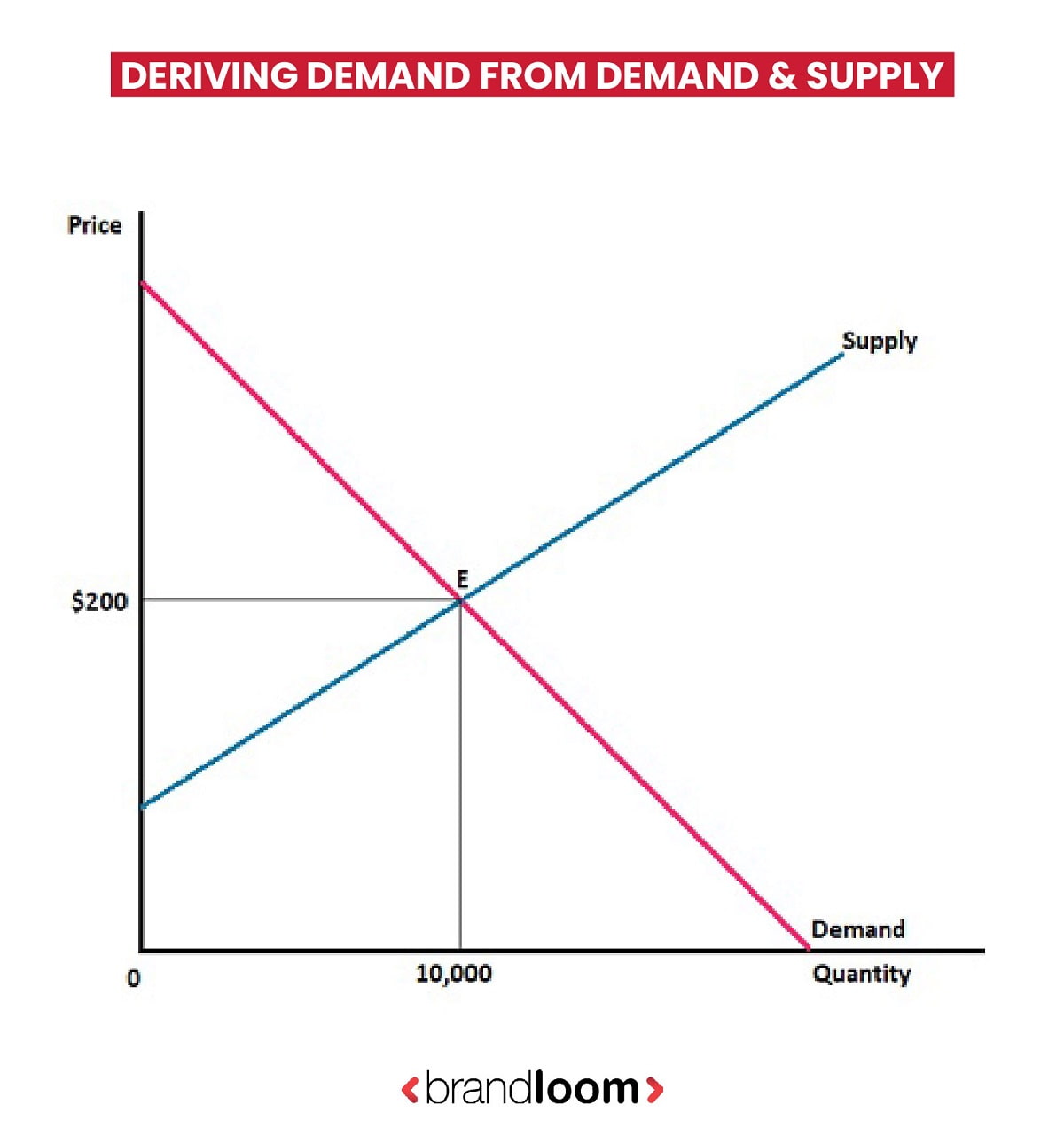 One may calculate a market price using the economic theory of supply and demand. The market price of a service or good is determined according to the law of supply and demand, which takes into account both the available supply and the demand for that good or service.
One may calculate a market price using the economic theory of supply and demand. The market price of a service or good is determined according to the law of supply and demand, which takes into account both the available supply and the demand for that good or service.


